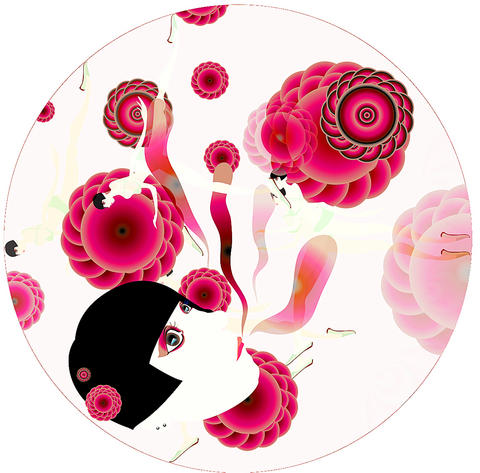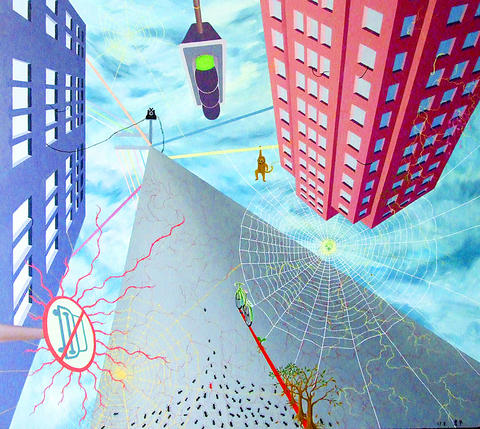Taiwan's so-called Strawberry Generation was born in the early 1980s and grew up during the country's economic boom. It is perceived by some as a group of young people who were overprotected by their parents and consequently too fragile to deal with the stress that accompanies adult life.
Zhang Qing (張晴) coined the term Gelatin Generation to describe a similar phenomenon in China.
Infantization (果凍時代), the exhibition he is curating at the Museum of Contemporary Art, Taipei, (MOCA, Taipei, 台北當代藝術館) highlights the artwork of this generation.

PHOTO: COURTESY OF MOCA, TAIPEI
The show, first displayed at MOCA, Shanghai, consists of 60 works of art by 41 artists from cities throughout China. They are organized along three themes: An Infantilized Youth, Portraiture of the Future and A disorderly Globalized Scene.
Though the experience of adults on either side of the Taiwan Strait has been different, judging from the works on view their children appear to have the same preoccupations.
The various images, photography, installations and videos - with the usual I-just-graduated themes of education, alienation and rapid modernization - mean that little is on view here that has not been thematically covered in other recent exhibitions of Asian art. But similarity to other exhibits makes Infantization of greater interest: It reveals that young Chinese artists are influenced by and have the same concerns as their South Korean, Japanese and Taiwanese counterparts. Though common symbols of Chinese-ness (such as pandas and pagodas) appear in some of the works, the artists aren't so much looking to their cultural roots for inspiration as they are delving into the pop styles of other Asian, and to a lesser extent, Western cultures.

PHOTO: COURTESY OF MOCA, TAIPEI
Ji Ji's (吉吉) Atomic Panda (原子態貓), with its three large panda sculptures - each with its own angry, happy and bemused facial expressions - appears to draw inspiration from the work of Japanese Pop artist Yoshimoto Nara to show an apocalyptic future, just as Huang Wei's (黃薇) digital prints Nude Show (赤裸的show) and Rave Party (狂野的派對) draw on the comic book art of Roy Liechtenstein to represent the urban party scene.
Anime rears its futuristic head in Marcie Liu's (劉慶) Future Anxiety Disorder, three digital prints that depict partially naked females in positions of extreme anxiety with helmets obscuring their faces.
Headless bodies and snake-like monsters characterize Zheng Suchai's (曾素釵) childlike painting Demolished Buildings and Displaced People (被拆遷的房子和搬家的人們) and speak of a generation isolated by the modernization policies of China's government.
Worry Hua's (虞華) City Series 1-3 (城市系列1-3) picks up on these themes but replaces people in her urban environments with cobwebs and cracked roads.
As one might imagine in an exhibit of recent graduates, school pressure and conformity feature prominently.
Xie Peng's (謝鵬) sexually violent comic strip, Terror, shows how the protagonist's classroom pressure leads to a terror spree on the streets, while images of a student choosing classes are juxtaposed with a man getting ready to fling himself from a building in Tang Wei's (唐威) video If I Jump (選修跳樓).
The relative freedom of Gelatin Generation artists to criticize the establishment, the show seems to suggest, reveals the increasing freedom of Chinese artists. The image of gelatin on the cover of the brochure for the Shanghai exhibit was exchanged with an image of a strawberry for the Taipei one, which seems to suggest that the two have underlying similarities.

In the March 9 edition of the Taipei Times a piece by Ninon Godefroy ran with the headine “The quiet, gentle rhythm of Taiwan.” It started with the line “Taiwan is a small, humble place. There is no Eiffel Tower, no pyramids — no singular attraction that draws the world’s attention.” I laughed out loud at that. This was out of no disrespect for the author or the piece, which made some interesting analogies and good points about how both Din Tai Fung’s and Taiwan Semiconductor Manufacturing Co’s (TSMC, 台積電) meticulous attention to detail and quality are not quite up to

April 21 to April 27 Hsieh Er’s (謝娥) political fortunes were rising fast after she got out of jail and joined the Chinese Nationalist Party (KMT) in December 1945. Not only did she hold key positions in various committees, she was elected the only woman on the Taipei City Council and headed to Nanjing in 1946 as the sole Taiwanese female representative to the National Constituent Assembly. With the support of first lady Soong May-ling (宋美齡), she started the Taipei Women’s Association and Taiwan Provincial Women’s Association, where she

Chinese Nationalist Party (KMT) Chairman Eric Chu (朱立倫) hatched a bold plan to charge forward and seize the initiative when he held a protest in front of the Taipei City Prosecutors’ Office. Though risky, because illegal, its success would help tackle at least six problems facing both himself and the KMT. What he did not see coming was Taipei Mayor Chiang Wan-an (將萬安) tripping him up out of the gate. In spite of Chu being the most consequential and successful KMT chairman since the early 2010s — arguably saving the party from financial ruin and restoring its electoral viability —

It is one of the more remarkable facts of Taiwan history that it was never occupied or claimed by any of the numerous kingdoms of southern China — Han or otherwise — that lay just across the water from it. None of their brilliant ministers ever discovered that Taiwan was a “core interest” of the state whose annexation was “inevitable.” As Paul Kua notes in an excellent monograph laying out how the Portuguese gave Taiwan the name “Formosa,” the first Europeans to express an interest in occupying Taiwan were the Spanish. Tonio Andrade in his seminal work, How Taiwan Became Chinese,